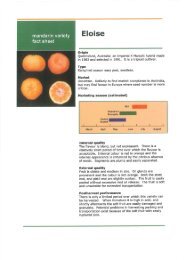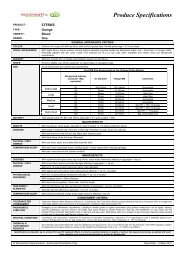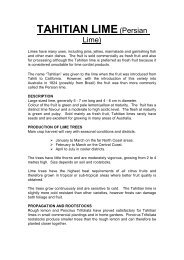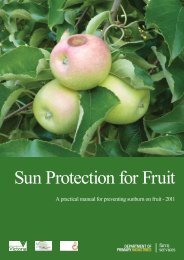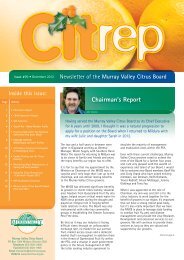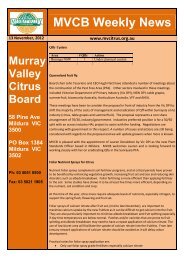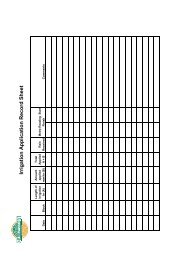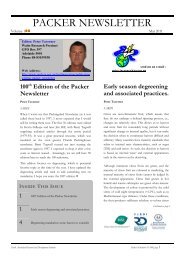Spined citrus bug - NSW Department of Primary Industries
Spined citrus bug - NSW Department of Primary Industries
Spined citrus bug - NSW Department of Primary Industries
You also want an ePaper? Increase the reach of your titles
YUMPU automatically turns print PDFs into web optimized ePapers that Google loves.
JUNE 2006 PRIMEFACT 217<br />
<strong>Spined</strong> <strong>citrus</strong> <strong>bug</strong><br />
Jianhua Mo<br />
Research Entomologist, Plant Health<br />
Sciences, Yanco<br />
Introduction<br />
<strong>Spined</strong> <strong>citrus</strong> <strong>bug</strong> (SCB), Biprorulus bibax<br />
(Pentatomidae: Hemiptera), feeds on the fruits <strong>of</strong><br />
lemons, mandarins and oranges, causing drying<br />
and brown staining <strong>of</strong> the fruit segments,<br />
gumming on the skin and premature fruit drop.<br />
Although native to Australia, SCB only emerged<br />
as a major <strong>citrus</strong> pest in the late 1980s. The<br />
major affected areas are inland regions <strong>of</strong><br />
southern New South Wales, Victoria and South<br />
Australia. Damage is mainly confined to lemons<br />
and mandarins, but instances <strong>of</strong> damage to<br />
oranges have been reported.<br />
Life cycle<br />
The SCB life cycle consists <strong>of</strong> an egg stage, five<br />
nymphal stages, and an adult stage (see Figs 1,<br />
2 and 3). Eggs are initially white but become<br />
mottled with black and red as they develop.<br />
Early-stage nymphs (stages I to III) are marked<br />
with black, green, yellow, white and orange.<br />
Late-stage nymphs (IV to V) are mainly green<br />
with black markings. Adults are green, 15–<br />
20 mm long, and have a pair <strong>of</strong> prominent spines<br />
on the shoulder <strong>of</strong> the thorax.<br />
Stage I nymphs congregate on empty egg shells<br />
and stay there until they reach stage II, when<br />
they disperse.<br />
Both adults and nymphs (except for stage I<br />
nymphs) feed on fruit. Lemons are preferred<br />
over other <strong>citrus</strong> fruits—the <strong>bug</strong>s pierce the rind<br />
<strong>of</strong> lemon fruit <strong>of</strong> any stage.<br />
Eggs are laid on leaves, fruit or twigs in batches<br />
<strong>of</strong> 4 to 36.<br />
Figure 1. Newly hatched SCB nymph on rough lemon<br />
Figure 2. Late-stage SCB nymph on rough lemon<br />
Figure 3. SCB adult on rough lemon<br />
Photos in Figures 1, 2 and 3 courtesy <strong>of</strong> Sandra Hardy.
Development and survival<br />
Development thresholds (T0) <strong>of</strong> individual stages<br />
<strong>of</strong> SCB range from 11.3°C to 17.5°C, and the<br />
thermal requirements range from 50 to 123<br />
degree-days (DD). The entire egg-to-adult<br />
development threshold requires a total <strong>of</strong><br />
455 DD above the threshold <strong>of</strong> 14.3°C. The<br />
fastest rates <strong>of</strong> nymphal and egg development<br />
occur between 32°C and 35°C; however,<br />
nymphal survival is highest between 25°C and<br />
30°C. Average survival <strong>of</strong> SCB from a stage I<br />
nymph to an adult varies from 41% to 63%.<br />
In New South Wales, Victoria and South<br />
Australia, there are three generations per year:<br />
in spring, summer and autumn. The number <strong>of</strong><br />
generations in Queensland is four: in spring,<br />
early summer, mid-summer, and autumn.<br />
Female adults can live for up to 18 months.<br />
Seasonal patterns<br />
In south-western New South Wales, adults are<br />
recorded in all months, with the greatest number<br />
found during winter. Oviposition occurs during<br />
October–April, with peaks in November and<br />
February/March. The number <strong>of</strong> eggs per batch<br />
is generally higher during October–December<br />
than during January–April.<br />
Nymphs are recorded in all months except<br />
August and September, and are most common<br />
during December–April. Nymphs <strong>of</strong> early stages<br />
(I–III) are dominant during spring and summer,<br />
and late-stage nymphs (IV–V) are most common<br />
in autumn and early winter.<br />
Aggregation behaviour<br />
Adults overwinter in aggregations on non-lemon<br />
<strong>citrus</strong> that are near lemons, or on their native<br />
host the desert lime, Eremo<strong>citrus</strong> glauca. Tight<br />
clusters <strong>of</strong> up to 50 adult <strong>bug</strong>s can be found in a<br />
single tree. A male-produced aggregation<br />
pheromone is responsible for the clustering. The<br />
pheromone is attractive to males and females,<br />
both reproductive and non-reproductive. A<br />
defence chemical common to stink <strong>bug</strong>s is also<br />
attractive to reproductive adults.<br />
The overwintering adults disperse in spring to<br />
nearby lemon blocks and begin egg-laying.<br />
Natural enemies<br />
SCB eggs are parasitised by at least 12 wasp<br />
species. The main parasitic wasps are:<br />
• Trissolcus oenone (Fig. 4), T. ogyges<br />
• Anastatus biproruli (Fig. 5)<br />
• Acroclisoides tectacorisi<br />
• Centrodora Darwini<br />
Figure 4. SCB egg parasitoid, Trissolcus oenone.<br />
Figure 5. SCB egg parasitoid Anastatus biproruli.<br />
Photos in Figures 4 and 5 courtesy <strong>of</strong> Smith et al. 1997.<br />
Parasitism can be as high as 60% to 100%, with<br />
highest parasitism occurring during spring to<br />
early summer.<br />
Predators <strong>of</strong> SCB nymphs and adults include:<br />
• spiders<br />
• predatory <strong>bug</strong>s<br />
• praying mantids<br />
• assassin <strong>bug</strong> (Pristhesancus plagipenis).<br />
Ants and lacewing larvae consume significant<br />
numbers <strong>of</strong> SCB eggs.<br />
Monitoring<br />
SCB populations and parasitism levels <strong>of</strong> SCB<br />
eggs should be monitored fortnightly during<br />
November-March. At each monitoring site, check<br />
an additional four to five neighbouring trees for<br />
the presence <strong>of</strong> adults and nymphs. To estimate<br />
the egg parasitism rate, collect five to ten egg<br />
batches and store them in separate containers to<br />
check for the emergence <strong>of</strong> <strong>bug</strong> nymphs and<br />
parasitic wasps. Search for winter aggregations<br />
<strong>of</strong> adults in the first two rows <strong>of</strong> non-lemon <strong>citrus</strong><br />
(oranges, mandarins, grapefruit).<br />
PRIMEFACT 217, SPINED CITRUS BUG 2
Management<br />
SCB management should be centred on the<br />
conservation <strong>of</strong> natural enemies, removal <strong>of</strong><br />
overwintering adults, and judicial use <strong>of</strong> low-rate,<br />
selective insecticides.<br />
Conservation <strong>of</strong> natural enemies is achieved by<br />
avoiding the use <strong>of</strong> harsh chemicals. Chemical<br />
intervention should be taken only when SCB<br />
pressure exceeds the action threshold. The<br />
recommended action threshold is 10% <strong>of</strong> trees<br />
infested with SCB adults or nymphs.<br />
Removal <strong>of</strong> overwintering adults can be<br />
significantly enhanced through the use <strong>of</strong><br />
aggregation pheromone.<br />
References<br />
James DG 1989, ‘Population biology <strong>of</strong><br />
Biprorulus bibax Breddin (Hemiptera:<br />
Pentatomidae) in a southern New South<br />
Wales <strong>citrus</strong> orchard’, Journal <strong>of</strong> the<br />
Australian Entomological Society, 28: 279–<br />
86.<br />
James DG 1990, ‘Development and survivorship<br />
<strong>of</strong> Biprorulus bibax (Hemiptera:<br />
Pentatomidae) under a range <strong>of</strong> constant<br />
temperatures’, Environmental Entomology<br />
19: 874–7.<br />
James DG 1990, ‘Seasonality and population<br />
development <strong>of</strong> Biprorulus bibax Breddin<br />
(Hemiptera: Pentatomidae) in south western<br />
New South Wales’, General and Applied<br />
Entomology, 22: 61–6.<br />
James DG 1994, ‘The development <strong>of</strong><br />
suppression tactics for Biprorulus bibax<br />
(Heteroptera: Pentatomidae) as part <strong>of</strong> an<br />
integrated pest management programme in<br />
<strong>citrus</strong> in inland south-eastern Australia’,<br />
Bulletin <strong>of</strong> Entomological Research 84: 31–8.<br />
James DG, Heffer R and Amaike M 1996, ‘Field<br />
attraction <strong>of</strong> Biprorulus bibax Breddin<br />
(Hemiptera: Pentatomidae) to synthetic<br />
aggregation pheromone and (E)-2-hexenal, a<br />
pentatomid defense chemical’, Journal <strong>of</strong><br />
Chemical Ecology, 22: 1697–1708.<br />
Mo J, Nicholas A, James D and Philpott K 2004,<br />
Development <strong>of</strong> an alternative to endosulfan<br />
in the IPM <strong>of</strong> spined <strong>citrus</strong> <strong>bug</strong>, Horticulture<br />
Australia Ltd, Sydney, Australia.<br />
Oliver JE, Aldrich JR, Lusby WR, Waters RM<br />
and James DG 1992, ‘A male-produced<br />
pheromone <strong>of</strong> the spined <strong>citrus</strong> <strong>bug</strong>’,<br />
Tetrahedron Letters, 33: 891–4.<br />
Smith D, Beattie GAC and Broadley R (eds)<br />
1997, Citrus pests and their natural enemies<br />
– integrated pest management in Australia,<br />
Queensland <strong>Department</strong> <strong>of</strong> <strong>Primary</strong><br />
<strong>Industries</strong>, Brisbane.<br />
Acknowledgment<br />
Australian Citrus Industry and Horticulture<br />
Australia Ltd provided funding for a series <strong>of</strong><br />
research projects on spined <strong>citrus</strong> <strong>bug</strong>.<br />
Published by <strong>NSW</strong> <strong>Department</strong> <strong>of</strong> <strong>Primary</strong> <strong>Industries</strong><br />
© State <strong>of</strong> New South Wales 2006<br />
ISSN 1832-6668<br />
Job number 6707<br />
Check for updates <strong>of</strong> this Primefact at:<br />
www.dpi.nsw.gov.au/primefacts<br />
Disclaimer: The information contained in this publication is<br />
based on knowledge and understanding at the time <strong>of</strong><br />
writing (June 2006). However, because <strong>of</strong> advances in<br />
knowledge, users are reminded <strong>of</strong> the need to ensure that<br />
information upon which they rely is up to date and to check<br />
currency <strong>of</strong> the information with the appropriate <strong>of</strong>ficer <strong>of</strong><br />
New South Wales <strong>Department</strong> <strong>of</strong> <strong>Primary</strong> <strong>Industries</strong> or the<br />
user’s independent adviser.<br />
PRIMEFACT 217, SPINED CITRUS BUG 3




